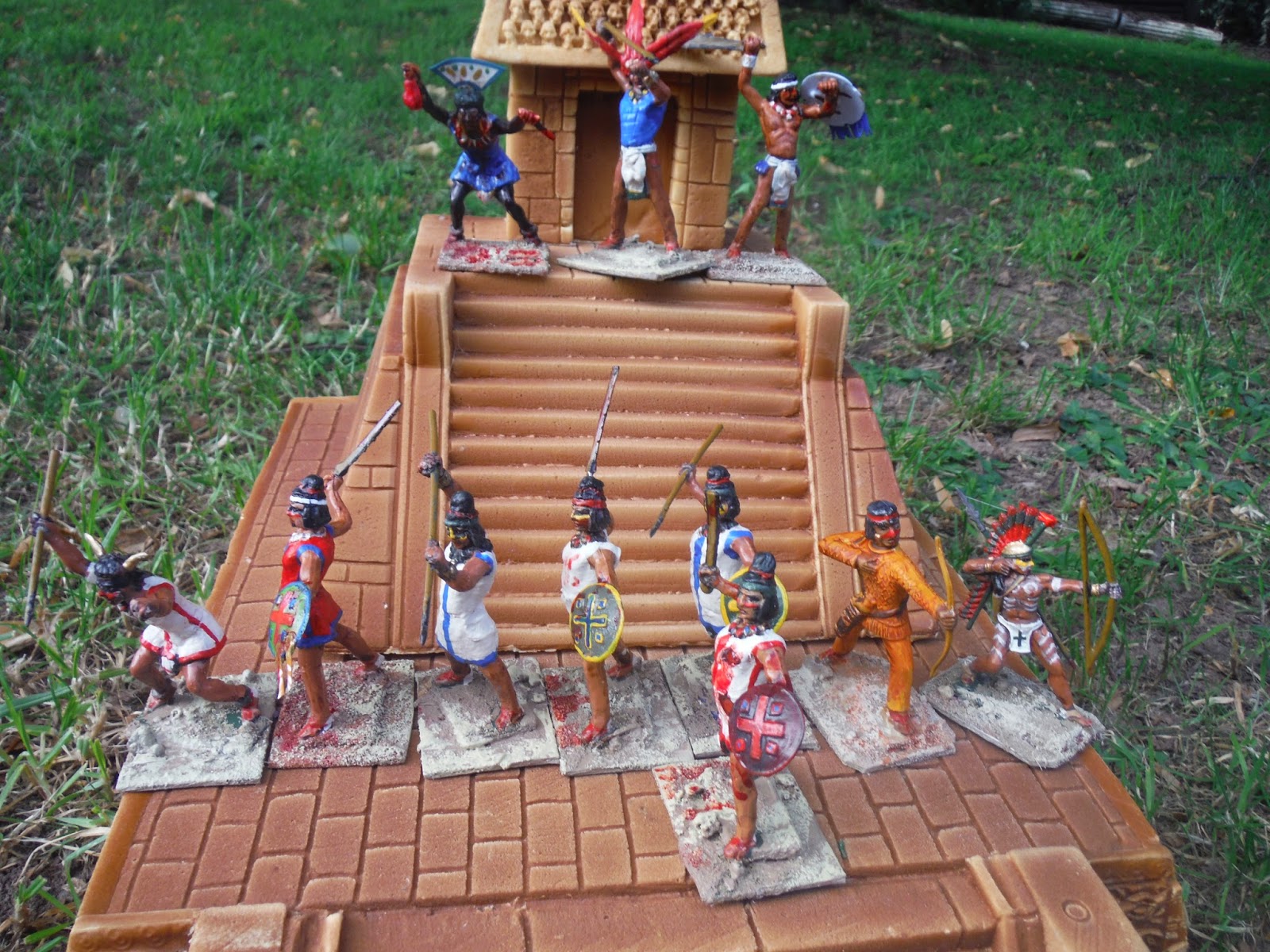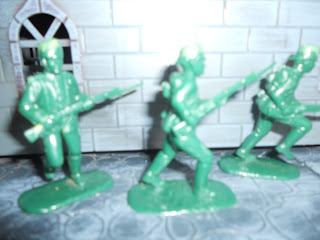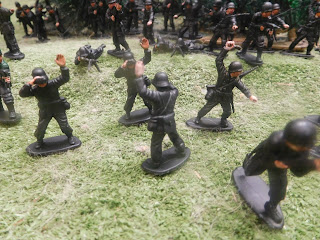Blood of the Aztecs
My acquisition of Bob and Tony's Cherilea and others Aztecs has hastened my Aztec project. The Cherilea Indians look vaguely Meso-American although they are North American Indians. Bob and Tony painted them up in some nice bright colours and initially I was just going to spruce up the skin tones and add some more facial details as most of them did not have eyes painted on them. That was before I had a look through my Osprey Aztec books and saw that the Aztecs did not wear kilts or trousers. They either had loin cloths only, loin cloths and padded cotton top with short sleeves or no sleeves or curious one piece outfits. White or off-white was common, especially for the loin cloths, and the clothing of the lower ranks but sometimes with coloured edging. Other clothes included tunics or vests made of cotton or padded cotton. The sandals had white material over the heel and two thongs, one between big toe and next toe and one between some of the smaller toes. These were often red. The higher ranks had more ostentatious colours and ornamentation Bright greens, blues, reds and yellows were used. Some wore helmets made of wood to depict coyotes, monsters, eagles and jaguars. The last two were known as 'knights, and formed particular warrior groups. Most units of Aztecs did not have a common colour of clothing and included a mixture of warrior types. The more elaborate were allowed to wear these costumes by virtue of their nobility or by their expertise in battle, through the capture of victims for sacrifice. This also gave them the privilege of eating them afterwards. It was kind of an extra incentive to join the army, as was the prohibition on men having sex until the had been successful in battle .The 'knights' and others had one piece outfits with an opening at the front where the loin cloth protruded. This was not a sash, as shown on the Cherilea Indians and Reamsa Aztecs. No did they wear their undies over their suits like Batman and Robin.
Estimates of human sacrifice numbers range from 20,000 to over one hundred thousand a year. I go with the figure of forty thousand plus. The steep stairs of the flat topped pyramids enabled the corpses to be rolled down the steps to be dismembered, the limbs being eaten by those privileged to do so and the torsos going to the royal zoo. The heart, which had been removed whilst the victim was alive, was held up still beating and then bunt in the idol's mouth. Some more inventive sacrifices involved making children cry by pricking their skin before they perished to create rain god pleasing tears. Fie god victims wee immolated short of death before having their hearts removed. The priests painted their own skin black, sharpened their teeth to points, didn't wash off the caked blood and enjoyed dancing around in the skin outfits fashioned from the victims. They also got to eat the victim's brains before placing the skulls on skull wracks. The Aztecs ate the human sacrifices in a nice tamale sauce. It sounds like a civilization designed by Hannibal Lector. On the other hand some historians believe it was a rational adaptation to a shortage of protein and over-population. They lacked herbivorous stock animals, having only Turkeys and small dogs domesticated for eating. Protein could be had from beans and maize but there were regular famines. Other historians point out that sacrifice does not correlate to famine times and it was for purely religious and political reasons that it occurred. Most likely it was a mixture of reasons, with the Aztecs believing themselves that making the sun come up, the rains come etc by appeasing the gods were the reason when other factors may have initiated the religious beliefs. In any case the Aztecs' neighbours were allowed to continue their societies in order to provide one big larder. Of course it might just be that the Aztecs liked the taste. Just like in Papua New Guinea pigs had not been introduced but when the were the natives recognized the similarity of taste.
Although they had gold in all else they were in the stone age, with no iron or bronze. Their wooded sword, that looked a little like cricket bats were edged in obsidian, as were their wooden headed spears. The also used wooden clubs with stone balls in the end, spear throwers and slings. Padded cotton clothing provided some protection although not against the weapons of Europeans.
Below - Top of pyramid is the Aztec priest in black paint holding up a heart. Bob or Tony had added the headdress from aluminium. The tunic is made from putty. Tony's great feathered figure, who looks a little like an Amazonian Indian or even a New Guinean native has had a sleeveless cotton tunic added. The next figure has had his leggings trimmed to bare legs as have a number of others. On the lower level I have included a Reamsa Indian in orange holding a bow and the Cresent Indian archer. The last is probably not accurate but looks good, especially with the spear on his back. Most of the Indians have added tunics from putty. The pyramid is Barzo, no longer produced.
I wasn't sure about the horns on one figure but left them in the end.
When I added the tunics over the existing sash-loin cloth the figures looked like pregnant women in mini dresses so I cut back into the putty and had a happy accident as the copper skin coloured plastic underneath the pared away putty reminded me of holes torn out of the clothing by the process of combat. So instead of filling them I accentuated them. I also added cuts and Games Work Shop Blood God paint which is glossy thin dark red paint. This I added after mat varnishing to have a glossier finish on the blood bits. I also splattered some on the ground and on weapons. Nice!
The birdman figure is really from a ceremony of an Indian tribe much further north but it looked good and I liked how tony added the hanging head. I added a tunic top. The accurate way to use this Cresent figure is to just use the head on another figure to make an Eagle Knight. The blue figure I mad from a copy of a herald Indian with club added. Thick paint was applied to represent the suit over a bare torso. As with most other figures I added a top knot to the hair. This was designed to offer some protection from blows to the head.
Lot's of blood - I think the conquistadors might have been here. The top knots were held in place by a band, often red in colour. The existing head band on the figure could have been covered over as it was not historically typical but I left them so the figures have two head bands. The figures jewellery looked appropriate.
Reamsa Aztecs with some Cherilea conversions for comparison.
Reamsa again but I am missing the conch blower.
The Jaguar knight has had the sides of his loin cloth-sash painted the same colour as the suit to disguise it although the sides of I should have been trimmed off.
Two Barzo figures and an early conversion I did from the birdman head on a ninja figure with appropriate putty additions and a shield and held Spanish helmet. Reamsa and Cherilea figures tower over these.
Left - Biblical David with sling, Cresent - Kellogg's Indian conversion and Jaguar Knight from Britains Detail Indian with pistol.
Barzo Indians with some work still to be done. Barzo are the most accurate but a little weedy and no longer in production.
Figures - I suggest 'regular Indians' with appropriate additions and reductions. Also Ninja figures have the one piece suits. Ancient and Dark Ages figures in tunics could also be modified fairly easily. Even cricketers might have potential!
Estimates of human sacrifice numbers range from 20,000 to over one hundred thousand a year. I go with the figure of forty thousand plus. The steep stairs of the flat topped pyramids enabled the corpses to be rolled down the steps to be dismembered, the limbs being eaten by those privileged to do so and the torsos going to the royal zoo. The heart, which had been removed whilst the victim was alive, was held up still beating and then bunt in the idol's mouth. Some more inventive sacrifices involved making children cry by pricking their skin before they perished to create rain god pleasing tears. Fie god victims wee immolated short of death before having their hearts removed. The priests painted their own skin black, sharpened their teeth to points, didn't wash off the caked blood and enjoyed dancing around in the skin outfits fashioned from the victims. They also got to eat the victim's brains before placing the skulls on skull wracks. The Aztecs ate the human sacrifices in a nice tamale sauce. It sounds like a civilization designed by Hannibal Lector. On the other hand some historians believe it was a rational adaptation to a shortage of protein and over-population. They lacked herbivorous stock animals, having only Turkeys and small dogs domesticated for eating. Protein could be had from beans and maize but there were regular famines. Other historians point out that sacrifice does not correlate to famine times and it was for purely religious and political reasons that it occurred. Most likely it was a mixture of reasons, with the Aztecs believing themselves that making the sun come up, the rains come etc by appeasing the gods were the reason when other factors may have initiated the religious beliefs. In any case the Aztecs' neighbours were allowed to continue their societies in order to provide one big larder. Of course it might just be that the Aztecs liked the taste. Just like in Papua New Guinea pigs had not been introduced but when the were the natives recognized the similarity of taste.
Although they had gold in all else they were in the stone age, with no iron or bronze. Their wooded sword, that looked a little like cricket bats were edged in obsidian, as were their wooden headed spears. The also used wooden clubs with stone balls in the end, spear throwers and slings. Padded cotton clothing provided some protection although not against the weapons of Europeans.
Below - Top of pyramid is the Aztec priest in black paint holding up a heart. Bob or Tony had added the headdress from aluminium. The tunic is made from putty. Tony's great feathered figure, who looks a little like an Amazonian Indian or even a New Guinean native has had a sleeveless cotton tunic added. The next figure has had his leggings trimmed to bare legs as have a number of others. On the lower level I have included a Reamsa Indian in orange holding a bow and the Cresent Indian archer. The last is probably not accurate but looks good, especially with the spear on his back. Most of the Indians have added tunics from putty. The pyramid is Barzo, no longer produced.
I wasn't sure about the horns on one figure but left them in the end.
When I added the tunics over the existing sash-loin cloth the figures looked like pregnant women in mini dresses so I cut back into the putty and had a happy accident as the copper skin coloured plastic underneath the pared away putty reminded me of holes torn out of the clothing by the process of combat. So instead of filling them I accentuated them. I also added cuts and Games Work Shop Blood God paint which is glossy thin dark red paint. This I added after mat varnishing to have a glossier finish on the blood bits. I also splattered some on the ground and on weapons. Nice!
The birdman figure is really from a ceremony of an Indian tribe much further north but it looked good and I liked how tony added the hanging head. I added a tunic top. The accurate way to use this Cresent figure is to just use the head on another figure to make an Eagle Knight. The blue figure I mad from a copy of a herald Indian with club added. Thick paint was applied to represent the suit over a bare torso. As with most other figures I added a top knot to the hair. This was designed to offer some protection from blows to the head.
Lot's of blood - I think the conquistadors might have been here. The top knots were held in place by a band, often red in colour. The existing head band on the figure could have been covered over as it was not historically typical but I left them so the figures have two head bands. The figures jewellery looked appropriate.
Reamsa Aztecs with some Cherilea conversions for comparison.
Reamsa again but I am missing the conch blower.
The Jaguar knight has had the sides of his loin cloth-sash painted the same colour as the suit to disguise it although the sides of I should have been trimmed off.
Two Barzo figures and an early conversion I did from the birdman head on a ninja figure with appropriate putty additions and a shield and held Spanish helmet. Reamsa and Cherilea figures tower over these.
Left - Biblical David with sling, Cresent - Kellogg's Indian conversion and Jaguar Knight from Britains Detail Indian with pistol.
Barzo Indians with some work still to be done. Barzo are the most accurate but a little weedy and no longer in production.
Weapon Conversions - broad swords have ends cut off and cuts made in the sides to represent obsidian wedges. Cricket bats could also serve! You can also cut notches in broad spear ends.
Figures - I suggest 'regular Indians' with appropriate additions and reductions. Also Ninja figures have the one piece suits. Ancient and Dark Ages figures in tunics could also be modified fairly easily. Even cricketers might have potential!
























Comments
Post a Comment